2002 Hyundai Grandeur weight
[x] Cancel search: weightPage 25 of 230
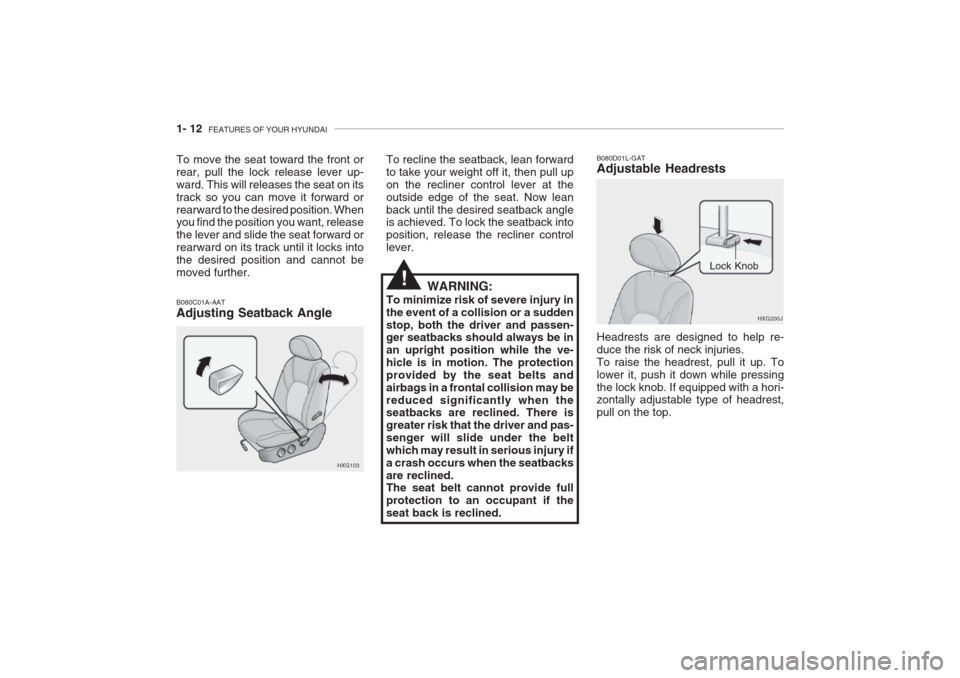
1- 12 FEATURES OF YOUR HYUNDAI
To move the seat toward the front or rear, pull the lock release lever up-ward. This will releases the seat on itstrack so you can move it forward orrearward to the desired position. When you find the position you want, release the lever and slide the seat forward orrearward on its track until it locks intothe desired position and cannot bemoved further.
HXG103
B080C01A-AAT Adjusting Seatback Angle
To recline the seatback, lean forward to take your weight off it, then pull upon the recliner control lever at theoutside edge of the seat. Now leanback until the desired seatback angle is achieved. To lock the seatback into position, release the recliner controllever.
WARNING:
To minimize risk of severe injury inthe event of a collision or a suddenstop, both the driver and passen- ger seatbacks should always be in an upright position while the ve-hicle is in motion. The protectionprovided by the seat belts andairbags in a frontal collision may bereduced significantly when the seatbacks are reclined. There is greater risk that the driver and pas-senger will slide under the beltwhich may result in serious injury ifa crash occurs when the seatbacksare reclined. The seat belt cannot provide full protection to an occupant if theseat back is reclined.
!
HXG200J
Lock Knob
B080D01L-GAT Adjustable Headrests Headrests are designed to help re- duce the risk of neck injuries.To raise the headrest, pull it up. Tolower it, push it down while pressingthe lock knob. If equipped with a hori- zontally adjustable type of headrest, pull on the top.
Page 49 of 230

1- 36 FEATURES OF YOUR HYUNDAI
WARNING:
o The side impact airbag is supple- mental to the driver's and the passenger's three point seat beltsystems and is not a substitutefor them. Therefore your seatbelts must be worn at all timeswhile the vehicle is in motion. The airbags deploy only in cer- tain side impact conditions se-vere enough to cause significantinjury to the vehicle occupants. HXGS261
Side airbag sensor
B990B04Y-GAT Side Impact Airbag (If installed)
Your Hyundai is equipped with a side airbag in each front seat. The purposeof the airbag is to provide the vehicle'sdriver and/or the front passenger with additional protection than that offered by the seatbelt alone. The side impactairbags are designed to deploy onlyduring certain side impact collisions,depending on the crash severity, angle,speed and point of impact. The air bags are not designed to deploy in all side impact situations. B990B02Y
!
WARNING:
The Passenger Presence Detection system is not intended to preventairbag deployment while a child isin the front passenger's seat. It is intended only as a means to reduce unnecessary collision damage re-pair expense by preventing airbagand seat belt pretensioner deploy-ment when the right front passen-ger seat is unoccupied. Deployment is still possible if only a few pounds are placed upon the seat. There-fore, children must not be trans-ported in the front seat. All childrenmust be seated in the rear seat andproperly restrained with the vehicle's restraint system or a child restraint system appropriate for thechild's size and weight.!
Page 85 of 230

1- 72 FEATURES OF YOUR HYUNDAI
B660A01S-GAT CRUISE CONTROL (If installed)
B660A02L
B660A01L-DAG
Left-Hand Drive Right-Hand Drive
Switch position
0 0 1 2
3Loading condition Driver onlyDriver + front passengerFull passengers (including driver) Full passengers (includ-ing driver) + full trunkloading (or light trailerloading)
Driver + full trunk load- ing (or maximum trailer
loading)
B340G02L
B340G02L.DAG
B340G02Y-GAT HEADLIGHT LEVELING DEVICE
SYSTEM (If Installed)
Left-Hand Drive Right-Hand Drive
To adjust the headlight beam level according to the number of the pas-sengers and the loading weight in theluggage area, turn the beam levelingswitch. The higher the number of the switch position, the lower the headlight beamlevel. Always keep the headlight beamat the proper leveling position, or head-lights may dazzle other road users.Listed below are the examples of proper switch settings. For loading conditions other than those listed below, adjustthe switch position so that the beamlevel may be the nearest as the condi-tion obtained according to the list.
Page 144 of 230

DRIVING YOUR HYUNDAI 2- 15
C150A01A-AAT SMOOTH CORNERING Avoid braking or gear changing in cor- ners, especially when roads are wet.Ideally, corners should always be takenunder gentle acceleration. If you followthese suggestions, tire wear will be held to a minimum. C160A01A-AAT WINTER DRIVING The more severe weather conditions of winter result in greater wear andother problems. To minimize the prob-lems of winter driving, you should fol-low these suggestions:
o Keep your car in good condition. For
better fuel economy and reducedmaintenance costs, maintain yourcar in accordance with the mainte-nance schedule in Section 5. If you drive your car in severe conditions, more frequent maintenance is re-quired (see Section 5 for details).
o Keep your car clean. For maximum service, your Hyundai should bekept clean and free of corrosive materials. It is especially important that mud, dirt, ice, etc. not be al-lowed to accumulate on the under-side of the car. This extra weightcan result in increased fuel con-sumption and also contribute to cor- rosion.
o Travel lightly. Don't carry unneces- sary weight in your car. Weight re- duces fuel economy.
o Don't let the engine idle longer than
necessary. If you are waiting (and not in traffic), turn off your engine and restart only when you're readyto go. C160B01A-GAT Snowy or Icy Conditions To drive your vehicle in deep snow, it may be necessary to use snow tires or to install tire chains on your tires. Ifsnow tires are needed, it is necessaryto select tires equivalent in size andtype of the original equipment tires. Failure to do so may adversely affect the safety and handling of your car.Furthermore, speeding, rapid accel-eration, sudden brake applications, andsharp turns are potentially very haz-ardous practices. During deceleration, use engine brak- ing to the fullest extent. Sudden brakeapplications on snowy or icy roadsmay cause skids to occur. You need tokeep sufficient distance between thevehicle in front and your vehicle. Also, apply the brake gently. It should be
o Remember, your Hyundai does not
require extended warm-up. As soon as the engine is running smoothly,you can drive away. In very coldweather, however, give your engine a slightly longer warm-up period.
o Don't "lug" or "over-rev" the engine. Lugging is driving too slowly in too high a gear resulting in the enginebucking. If this happens, shift to alower gear. Over-revving is racing the engine beyond its safe limit. This can be avoided by shifting atthe recommended speeds.
o Use your air conditioning sparingly. The air conditioning system is oper-ated by engine power so your fuel economy is reduced when you use it.
Page 145 of 230
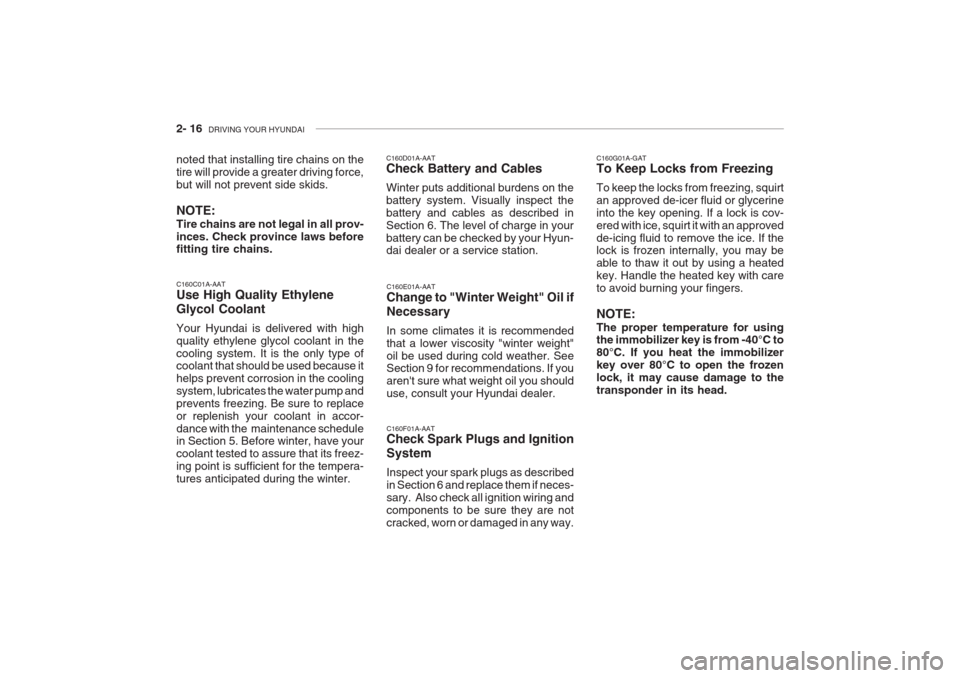
2- 16 DRIVING YOUR HYUNDAI
C160F01A-AAT Check Spark Plugs and Ignition System Inspect your spark plugs as described in Section 6 and replace them if neces-sary. Also check all ignition wiring andcomponents to be sure they are notcracked, worn or damaged in any way. C160G01A-GAT To Keep Locks from Freezing To keep the locks from freezing, squirt an approved de-icer fluid or glycerineinto the key opening. If a lock is cov-ered with ice, squirt it with an approvedde-icing fluid to remove the ice. If the lock is frozen internally, you may be able to thaw it out by using a heatedkey. Handle the heated key with careto avoid burning your fingers. NOTE: The proper temperature for using the immobilizer key is from -40°C to 80°C. If you heat the immobilizerkey over 80°C to open the frozenlock, it may cause damage to thetransponder in its head.
C160C01A-AAT Use High Quality Ethylene Glycol Coolant Your Hyundai is delivered with high quality ethylene glycol coolant in thecooling system. It is the only type of coolant that should be used because it helps prevent corrosion in the coolingsystem, lubricates the water pump andprevents freezing. Be sure to replaceor replenish your coolant in accor-dance with the maintenance schedule in Section 5. Before winter, have your coolant tested to assure that its freez-ing point is sufficient for the tempera-tures anticipated during the winter. C160D01A-AAT Check Battery and Cables Winter puts additional burdens on the battery system. Visually inspect thebattery and cables as described inSection 6. The level of charge in yourbattery can be checked by your Hyun- dai dealer or a service station.
C160E01A-AATChange to "Winter Weight" Oil if Necessary In some climates it is recommended that a lower viscosity "winter weight"oil be used during cold weather. See Section 9 for recommendations. If you aren't sure what weight oil you shoulduse, consult your Hyundai dealer.
noted that installing tire chains on thetire will provide a greater driving force,but will not prevent side skids. NOTE: Tire chains are not legal in all prov- inces. Check province laws before fitting tire chains.
Page 148 of 230
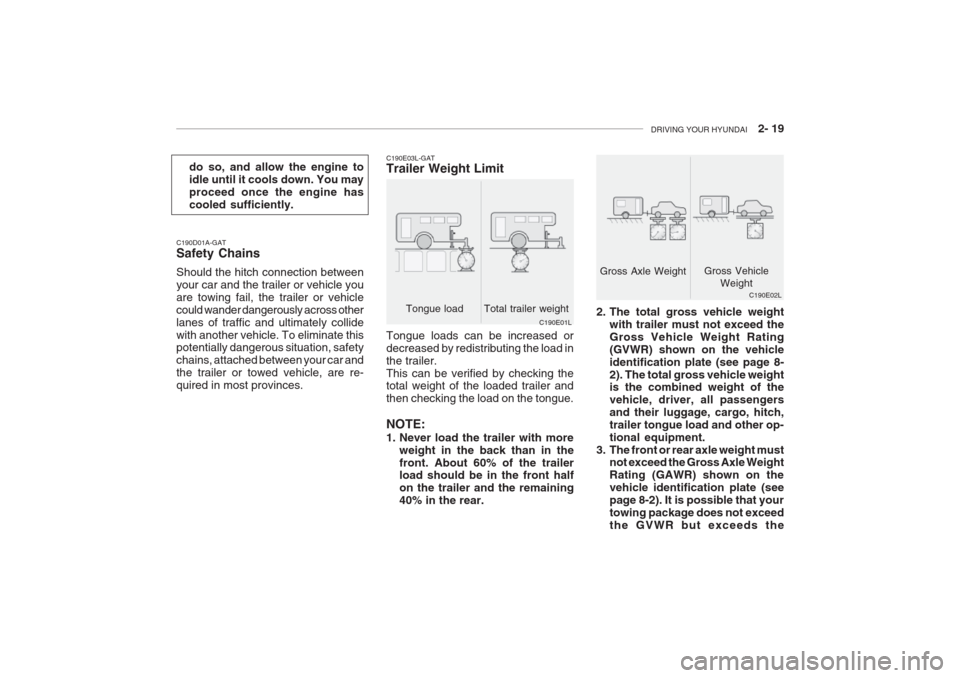
DRIVING YOUR HYUNDAI 2- 19
C190E03L-GAT Trailer Weight Limit
Tongue load Total trailer weight C190E01L2. The total gross vehicle weight
with trailer must not exceed the Gross Vehicle Weight Rating(GVWR) shown on the vehicleidentification plate (see page 8-2). The total gross vehicle weight is the combined weight of the vehicle, driver, all passengersand their luggage, cargo, hitch,
trailer tongue load and other op-tional equipment.
3. The front or rear axle weight must not exceed the Gross Axle Weight
Rating (GAWR) shown on thevehicle identification plate (seepage 8-2). It is possible that yourtowing package does not exceedthe GVWR but exceeds the
C190D01A-GAT Safety Chains Should the hitch connection between your car and the trailer or vehicle youare towing fail, the trailer or vehiclecould wander dangerously across otherlanes of traffic and ultimately collidewith another vehicle. To eliminate this potentially dangerous situation, safety chains, attached between your car andthe trailer or towed vehicle, are re-quired in most provinces.
Tongue loads can be increased ordecreased by redistributing the load inthe trailer.This can be verified by checking the total weight of the loaded trailer and then checking the load on the tongue. NOTE:
1. Never load the trailer with more
weight in the back than in the front. About 60% of the trailer load should be in the front half on the trailer and the remaining40% in the rear.
do so, and allow the engine toidle until it cools down. You may
proceed once the engine hascooled sufficiently.
C190E02L
Gross Axle Weight
Gross Vehicle
Weight
Page 149 of 230
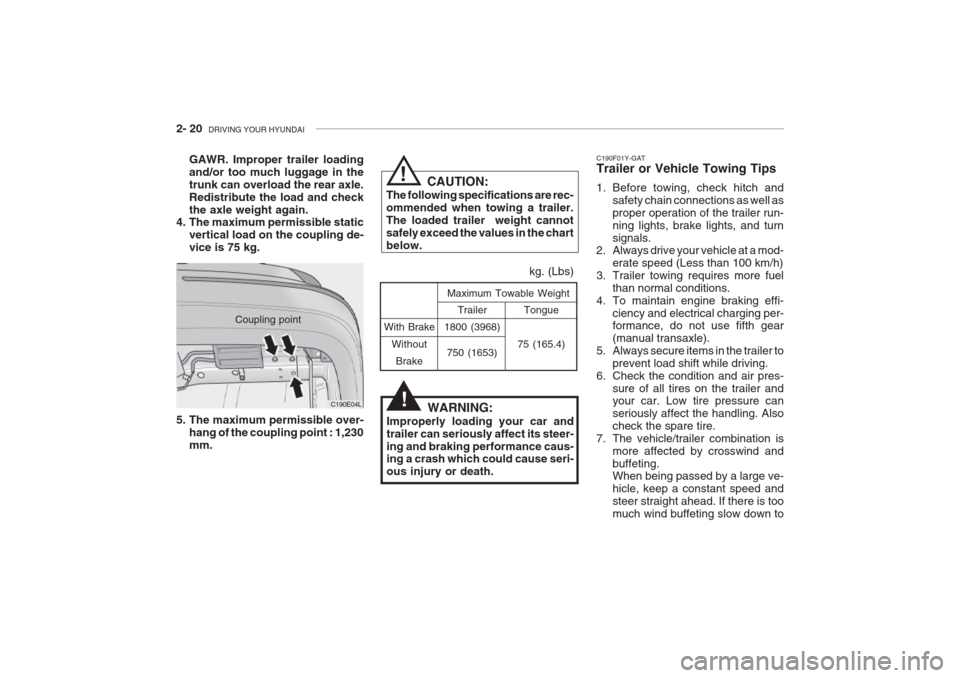
2- 20 DRIVING YOUR HYUNDAI
With Brake
WithoutBrake Tongue
75 (165.4)
Maximum Towable Weight
kg. (Lbs)
Trailer
1800 (3968)
750 (1653)
WARNING:
Improperly loading your car and trailer can seriously affect its steer-ing and braking performance caus- ing a crash which could cause seri- ous injury or death. C190F01Y-GAT Trailer or Vehicle Towing Tips
1. Before towing, check hitch and
safety chain connections as well as proper operation of the trailer run-ning lights, brake lights, and turnsignals.
2. Always drive your vehicle at a mod-
erate speed (Less than 100 km/h)
3. Trailer towing requires more fuel
than normal conditions.
4. To maintain engine braking effi-
ciency and electrical charging per- formance, do not use fifth gear (manual transaxle).
5. Always secure items in the trailer to prevent load shift while driving.
6. Check the condition and air pres-
sure of all tires on the trailer and your car. Low tire pressure can seriously affect the handling. Alsocheck the spare tire.
7. The vehicle/trailer combination is more affected by crosswind andbuffeting. When being passed by a large ve- hicle, keep a constant speed andsteer straight ahead. If there is toomuch wind buffeting slow down to
Coupling point
C190E04L
GAWR. Improper trailer loadingand/or too much luggage in thetrunk can overload the rear axle.Redistribute the load and checkthe axle weight again.
4. The maximum permissible static
vertical load on the coupling de-vice is 75 kg. CAUTION:
The following specifications are rec-ommended when towing a trailer.The loaded trailer weight cannotsafely exceed the values in the chartbelow.
!
!
5. The maximum permissible over- hang of the coupling point : 1,230 mm.
Page 202 of 230
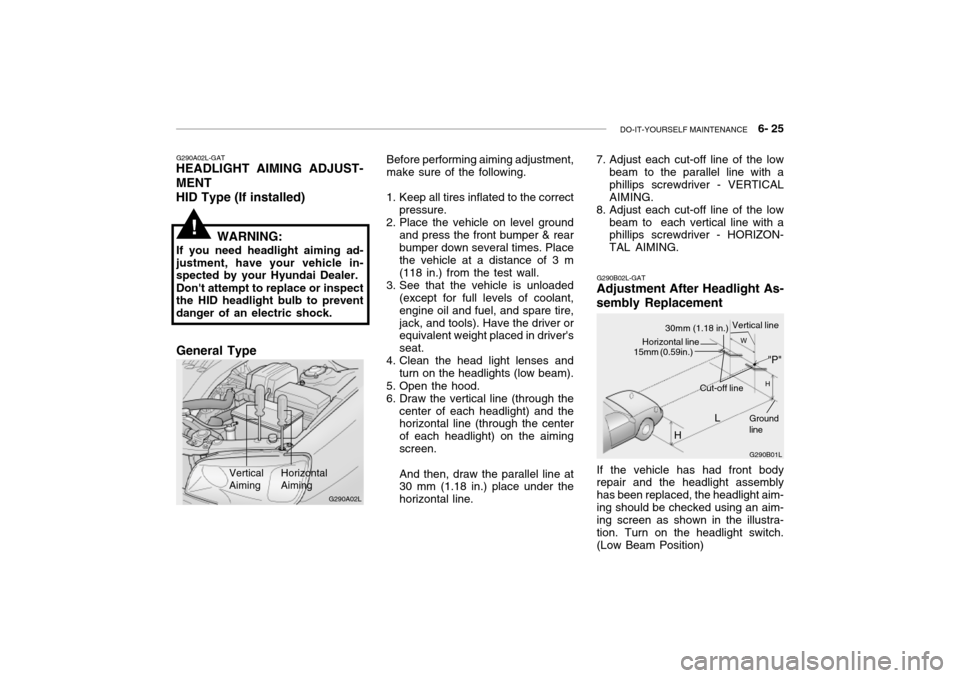
DO-IT-YOURSELF MAINTENANCE 6- 25
G290A02L-GAT
HEADLIGHT AIMING ADJUST- MENT
HID Type (If installed)
WARNING:
If you need headlight aiming ad- justment, have your vehicle in- spected by your Hyundai Dealer. Don't attempt to replace or inspect the HID headlight bulb to prevent danger of an electric shock.
Vertical Aiming HorizontalAiming
Before performing aiming adjustment, make sure of the following.
1. Keep all tires inflated to the correct pressure.
2. Place the vehicle on level ground
and press the front bumper & rear bumper down several times. Place the vehicle at a distance of 3 m (118 in.) from the test wall.
3. See that the vehicle is unloaded (except for full levels of coolant,engine oil and fuel, and spare tire,jack, and tools). Have the driver or equivalent weight placed in driver's seat.
4. Clean the head light lenses and
turn on the headlights (low beam).
5. Open the hood.
6. Draw the vertical line (through the center of each headlight) and the horizontal line (through the center of each headlight) on the aimingscreen. And then, draw the parallel line at 30 mm (1.18 in.) place under the horizontal line.
!
G290B02L-GAT
Adjustment After Headlight As- sembly Replacement
G290B01L
LW
H
H Cut-off line
Ground line
If the vehicle has had front body repair and the headlight assembly has been replaced, the headlight aim-ing should be checked using an aim- ing screen as shown in the illustra- tion. Turn on the headlight switch.(Low Beam Position)
"P"
Horizontal line15mm (0.59in.)
30mm (1.18 in.) Vertical line
7. Adjust each cut-off line of the low
beam to the parallel line with a phillips screwdriver - VERTICALAIMING.
8. Adjust each cut-off line of the low
beam to each vertical line with a phillips screwdriver - HORIZON- TAL AIMING.
G290A02L
General Type